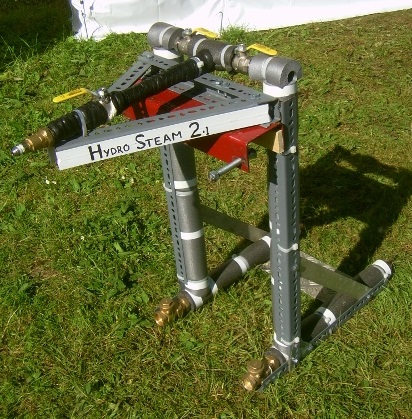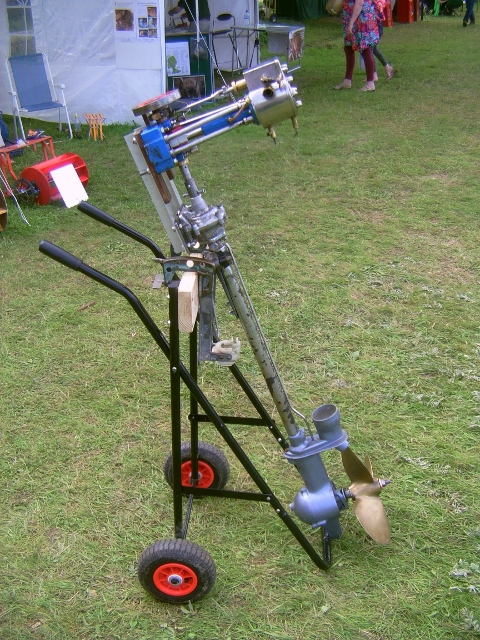
The entries for the first ever Steam Outboard Motor Challenge are described below. This event was highly entertaining and warm thanks must go to Kingsley Robinson, whose idea it was, and to all who built entries and ran them at Beale Park. The Host Boat, providing steam from its kerosene-fired boiler, was Chimera II.
David Avery was all set to change the face of steamboating as we know it. What he made was a neat arrangement of pipes and ball valves, the idea being to gain propulsion by means water ejection. Steam lifted the water from the lake ( in theory) and pushed it out of the ejector tubes to thrust the host boat at high speed across the water. Using a fair bit of Chimera II's kerosene to produce as much steam as possible, it emitted an interesting bubbly farting sound and projected the boat approximately 28mm.
.jpg)
John Barnard's entry had a strong whiff of Briggs & Stratton about it and his conversion of a 4 stroke lawn mower engine was as elegant as it was effective. This nifty engine used the original engine valves simply with a much altered camshaft. Linked to a plywood paddle made of old bookshelves this creation pushed Chimera II manfully across the lake showering everything and everybody in a wild deluge. It was impressive and cost just £17 to build.
 John Winn
John Winn had remorselessly confiscated a neat vertical single from the workshop of a friend in Didcot who shall remain nameless unless you read further. Mounted on a Seagull leg and gearbox it put up a fight initially by breaking its piston rod. John burned a candle until the wee hours back home in his workshop and the restored engine put up a very creditable run on the last day. A look at the pictures shows that Chimera II was ballasted for this run with some of the SBA's serious heavyweights (names like Rudall and Schofield stand as charged) and had some of that excess lard been shed, or used for lubrication, John is pretty sure his entry would have skimmed effortlessly across the lake and blown away all competition.
.jpg)
John Schofield's creation was powered by another small vertical engine and this was the only entry with the potential to go backwards if desired. But to have gone forwards would have been an impressive advantage. Thus all the technical innovation was immaterial since drive to the wooden paddle was by bicycle sprocket and chain and the thing had no desire to hang on to its chain for any worthwhile length of time. A credit to the mighty workshop facilities that built Magic Dragon it was a frightening machine and an affront to the H&E executive, but it showed promised for a few microseconds before disintegrating entertainingly and lapsing into sullen non-cooperation.
.jpg) Mike Robinson
Mike Robinson presented what was most certainly the most imposing and technically awesome entry. It was twin-beam atmospheric - i.e Newcomen - paddle engine. It was beautifully and extremely elegantly engineered, the massed expertise of Robinsons in Wales and Sheffield having been pressed into production of components, including exquisitely neat floats to enable it to be anchored to the transom board of the host boat and supported at its other end by the water itself.
This monster had two runs, the first using direct condensing water injection into the cylinders resulting in hydraulic lock-up and a fearfully bent piston rod on one side. This was repaired and condensing water on the next run was squirted on the outside of the cylinders, with the help of skillfully wielded of plastic cups. It looked fantastic, was enormous fun, the audiences loved it, and we can report with some pride that it did make a revolution or two under its own power. To overhear the development team discussing technical moves had all the intensity of a F1 team discussing how they might extract a further 0.3 of a BHP out of a highly-stressed racing engine.
On reflection to be able to get as much as 0.3 of a BHP out of Newcomen's 18th century mine pumping technology would have been impressive. This engine was though, as aforesaid, an awesome beast and we hope to see it again!
.jpg)
Ian McAlpine, though, deserved to be declared the winner. There are not many forms of steam engine left untried or unmade by Ian and his four-cylinder cruciform engine had poppet valves and went like a rocket. He disdained mounting a steam engine on the remains of a superannuated Seagull, and made his own leg, bottom end gearbox and prop. He even polished his steampipes and arrived at Beale Park with this machine neatly affixed to a Zimmer walking frame which in some subtle way conveyed a message to the many SBA members present. No doubt some old person in the Didcot area had to spend the entire weekend unable to get up to go the loo, but they can be assured it was all worth it. The engine ran as impressively as it looked.
Mark Rudall